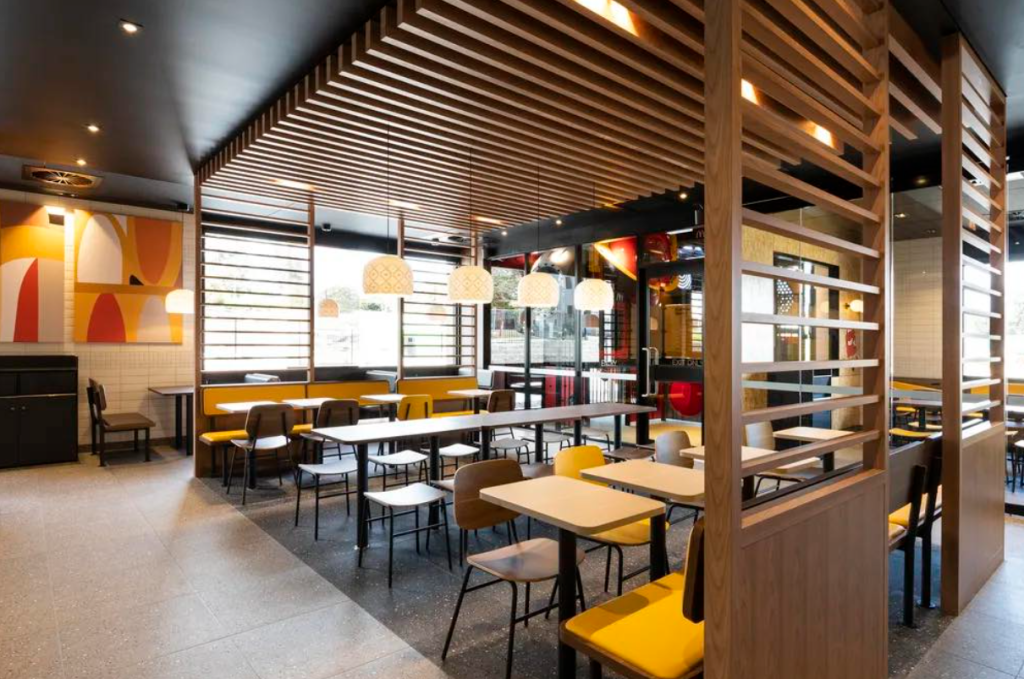Join the Expert Committee for the 2024 3D Printing Industry Awards to help select the winners!
Fast food giant McDonald’s has partnered with Philips MyCreation, a division of Philips, to implement a novel lighting design concept using 3D printing.
The plan is to install custom 3D printed light fixtures in all 38,000 McDonald’s locations, featuring unique embossed circular pendants. By producing these lampshades with recyclable materials at nearby facilities, McDonald’s aims to reduce shipping pollution, cut utility costs, and minimize waste compared to traditional methods.

Innovative pendant lighting design with eco-friendly features
According to Marc Pochert, Senior Director of Global Design Integration at McDonald’s, he initially doubted the feasibility of their lighting concept, which required a unique design not available off-the-shelf. The design included pendant lights with a translucent, hemispherical structure, an embossed surface pattern, and a different pattern on the top.
The complexity of producing the required mold posed significant challenges for McDonald’s. However, after discovering Philips MyCreation’s capabilities on social media, the team decided to reach out. Following two rounds of 3D printed samples, McDonald’s became confident in Philips MyCreation’s ability to meet their requirements.
In just three months, the 3D printed pendant light fixture design received approval and validation. This solution not only met McDonald’s design expectations but also aligned with its sustainability goals, which include a 60% reduction in carbon footprint by 2030. By using at least 55% recycled or bio-circular plastics and producing lamp shades locally, transport emissions were reduced and delivery times shortened. Furthermore, on-demand production eliminated the need for large inventories.
According to the fast-food giant, the partnership will be scaled up worldwide, with McDonald’s intending to introduce the Philips MyCreation lighting solution in restaurants across over 100 countries by 2023. This rollout will cover regions from Argentina to Japan, and from Alaska to Australia.
Elsewhere, Philips MyCreation has created lighting solutions for various clients, such as a pendant light for Signify at Milan Design Week 2024. It also developed tilted fixtures for SeaWorld Yas Island in Abu Dhabi and provided lighting solutions for the Dutch supermarket chain PLUS.
3D printing lighting systems
3D printing helps create custom and intricate lighting fixtures with greater design flexibility compared to traditional methods. It uses various materials like plastics and metals, allowing for unique, personalized solutions while reducing waste and enabling efficient, localized production.
One notable example includes creative design studio Urban Scale Interventions (USI) unveiling an immersive lighting and sound installation in Belfast’s historic ‘Entries’ area. Featuring 43 suspended ‘ocean orbs’ made with Ultimaker S5 3D printers and recycled PETG filament from Filamentive, the installation was designed to enhance safety and reflect the site’s history. Initiated by Belfast City Council’s placemaking strategy, the project aimed to create a welcoming space for visitors and became a popular attraction outside Whites Tavern.
On another note, the Lighting Research Center (LRC) and Eaton Corporation partnered to develop a fully 3D printed LED-integrated luminaire. Funded by the U.S. Department of Energy (DoE), the project aimed to advance the adoption of AM in solid-state lighting (SSL) by exploring cost-effective, 3D printed systems. This research focused on material science, electronics, optics, and advanced manufacturing, to achieve sustainable production and reduce waste.
Back in 2015, OceanLED collaborated with Protolabs to develop a low-energy LED lighting system for yachts, creating a unique “aquarium effect” underwater. Initially focused on high-end yachts, OceanLED transitioned to using polymer-based prototypes to optimize costs for smaller boats. Its Protomold division developed the Amphibian line, the first lighting collection for both underwater and above-water use, through iterative 3D printing and injection molding.
What 3D printing trends do the industry leaders anticipate this year?
What does the Future of 3D printing hold for the next 10 years?
To stay up to date with the latest 3D printing news, don’t forget to subscribe to the 3D Printing Industry newsletter or follow us on Twitter, or like our page on Facebook.
While you’re here, why not subscribe to our Youtube channel? Featuring discussion, debriefs, video shorts, and webinar replays.
Featured image shows McDonald’s partners with Philips MyCreation for innovative lighting. Photo via Philips MyCreations.



